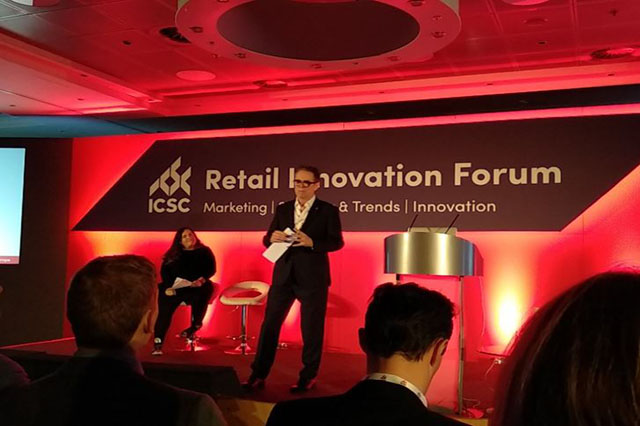Last week, the Coresight Research team attended the ICSC Retail Innovation Forum in Amsterdam. Coresight Research Analyst Filippo Battaini delivered a presentation on how technology will impact the future of brick-and-mortar stores.Here, we share our top takeaways from the event.
Retail-Tech Innovation: What’s on the Horizon?
Battaini shared a vision of the future in which technology will play a key role in digitizing physical stores. He said that retailers will use computer vision and AI to assist human employees in providing an enhanced shopping experience, but that human interaction will remain important. Battaini thinks that the brick-and-mortar store of the future will combine the personalized approach that sales associates provide with technologies that maximize efficiencies and improve the shopper experience. Retailers are likely to use completely unstaffed stores to complement, rather than replace, staffed stores as part of their multichannel strategies.
What Retailers Can Learn from Innovation in the Hospitality Industry
David Kijlstra, Commercial Manager at Zoku Amsterdam, described how Zoku—one of the 25 coolest hotels in the world, according to Forbes—has been continuously innovating to meet guests’ preferences and discussed how this experience can be transferable to retail.
Just like retail, the hospitality industry has been disrupted by online competitors, Kijlstra noted. In the case of hotels, Airbnb has been a primary disruptor. So, hotels need to innovate to stay relevant. Zoku looked at the worldwide trends of mobility, flexibility and globalization, and conceived an offering that caters to professionals relocating to dynamic cities for work. The company turned hotel rooms into mini apartments that provide a living space for stays of short to medium length.Retailers can look to Zoku as an example of how to innovate by addressing consumers’ requirements in new ways, Kijlstra said.
Active Lives Demand Active Brands
Christian Ward, Head of Media and Marketing at research and advisory firm Stylus, shared the trends and strategies that are driving brands as they respond to consumers living active lives. He said that consumers’ increasingly active lifestyles create commercial opportunities, and that brands and retailers can embrace these opportunities by providing consumers with personalization and experiences. For example, at the Nike By You Studio, shoppers can design their own shoes, and at the Puma Future Vault, visitors can get together and challenge others to a soccer game.
Bringing Them Back: How to Attract Digital Customers to the Store
Lara Marrero, Strategy Director and Global Retail Practice Leader at design and architecture firm Gensler, said that the role of the physical store in modern retail has been redefined. Digitalization has changed the way consumers shop, and the physical store is now just one of the channels available. In this new context, physical stores must become places where shoppers go to experience products, not just see and buy them, Marrero said. Retailers and brands can even come together to organize joint initiatives, she noted. At 29Rooms, for example, brand-sponsored art installations attract visitors and raise brand awareness among shoppers.
Positive Disruption: Understanding the New Customer
Ken Hughes, a leading consumer and shopper behavioralist, gave an overview of how Gen Z consumers and technology are disrupting retail. Hughes introduced the concept of the “blue dot consumer”—named after the blue dot that identifies a location on a Google Map. According to this concept, shoppers do not go to a retailer anymore; rather, the retailer must make its way to the consumer. Personalization is key to reaching blue dot consumers, Hughes said,and dialog between a retailer or brand and a consumer must be based on the consumer’s preferences and circumstances. Hughes also confirmed that providing experiences is key to engaging with blue dot consumers. He cited the KitKat Chocolatory as an example, noting that the confectionery brand gives consumers the opportunity to make their own personalized KitKat on-site.
Innovation or Invasion? Tech in Retail: Bridging the Gap
Karen Harris, Managing Director at IntuDigital, Intu’s technology and innovation hub, also talked about the impact of technology on the future of retail. In the current digital-first retail landscape, the physical store needs to complement digital channels to become the space in which shoppers can experience products, Harris said. This new function will effectively turn brick-and-mortar stores into a media channel. Harris added that, in the US, physical store experiences will be the second-biggest channel for marketing spending by 2020.
The Retail World in the Age of Digital-First
CateTrotter, Head of Trends at consultancy firm Insider Trends, showed some examples of brands leading the way in the integration of digital-first retailing in physical stores. Trotter noted a discrepancy in retail: according to Insider Trends, most shoppers prefer shopping online versus shopping in physical stores, but stores still account for the majority of sales. The best way to address this discrepancy is for retailers to adopt technology to digitize the in-store experience, Trotter said. Stores must become both functional and experiential, a place where shoppers go to get personal advice and try products firsthand. Trotter noted that US department store Nordstrom has created a new, smaller format called Nordstrom Local that is 2% the size of the retailer’s regular stores. Shoppers can visit these new stores for pre-bookable personal shopping advice.
At the end of the session, Trotter recommended that retailers think about how to create the perfect digital-first ecosystem to match shoppers’ needs and suggested that they consider how physical stores can best cater to consumers’ preferences.
